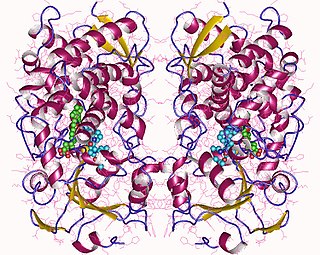
Modafinil, sold under the brand name Provigil among others, is a wakefulness-promoting medication used primarily to treat narcolepsy, a sleep disorder characterized by excessive daytime sleepiness and sudden sleep attacks. Modafinil is also approved for stimulating wakefulness in people with sleep apnea and shift work sleep disorder. It is taken by mouth. Modafinil is not approved by the US Food and Drug Administration (FDA) for use in people under 17 years old.

Nootropics, colloquially brain supplements, smart drugs and cognitive enhancers, are natural, semisynthetic or synthetic compounds which purportedly improve cognitive functions, such as executive functions, attention or memory.
A dopamine reuptake inhibitor (DRI) is a class of drug which acts as a reuptake inhibitor of the monoamine neurotransmitter dopamine by blocking the action of the dopamine transporter (DAT). Reuptake inhibition is achieved when extracellular dopamine not absorbed by the postsynaptic neuron is blocked from re-entering the presynaptic neuron. This results in increased extracellular concentrations of dopamine and increase in dopaminergic neurotransmission.

Cytochrome P450 3A4 is an important enzyme in the body, mainly found in the liver and in the intestine, which in humans is encoded by CYP3A4 gene. It oxidizes small foreign organic molecules (xenobiotics), such as toxins or drugs, so that they can be removed from the body. It is highly homologous to CYP3A5, another important CYP3A enzyme.

Adrafinil, sold under the brand name Olmifon, is a wakefulness-promoting medication that was formerly used in France to improve alertness, attention, wakefulness, and mood, particularly in the elderly. It was also used off-label by individuals who wished to avoid fatigue, such as night workers or others who needed to stay awake and alert for long periods of time. Additionally, the medication has been used non-medically as a novel vigilance-promoting agent.

Tiotixene, or thiothixene is a typical antipsychotic agent currently sold under the brand name Navane which is predominantly utilised to treat acute and chronic schizophrenia. Beyond its primary indication, it can exhibit a variety of effects common to neuroleptic drugs including anxiolytic, anti-depressive, and anti-aggressive properties.

Armodafinil, sold under the brand name Nuvigil, is a wakefulness-promoting medication which is used to treat excessive daytime sleepiness associated with obstructive sleep apnea, narcolepsy, and shift work disorder. It is also used off-label for certain other indications. The drug is taken by mouth.

Pinazepam is a benzodiazepine drug. It possesses anxiolytic, anticonvulsant, sedative and skeletal muscle relaxant properties.

Medifoxamine, previously sold under the brand names Clédial and Gerdaxyl, is an atypical antidepressant with additional anxiolytic properties acting via dopaminergic and serotonergic mechanisms which was formerly marketed in France and Spain, as well as Morocco. The drug was first introduced in France sometime around 1990. It was withdrawn from the market in 1999 (Morocco) and 2000 (France) following incidences of hepatotoxicity.

Deramciclane (EGIS-3886) is a non-benzodiazepine-type anxiolytic drug to treat various types of anxiety disorders. Deramciclane is a unique alternative to current anxiolytics on the market because it has a novel chemical structure and target. It acts as an antagonist at the 5-HT2A receptor, as an inverse agonist at the 5-HT2C receptor, and as a GABA reuptake inhibitor. The two serotonin receptors are G protein-coupled receptors and are two of the main excitatory serotonin receptor types. Their excitation has been implicated in anxiety and mood. Deramciclane does not affect CYP3A4 activity in metabolizing other drugs, but it is a weak inhibitor of CYP2D6. Some studies also show the drug to have moderate affinity to dopamine D2 receptors and low affinity to dopamine receptor D1. Researchers are looking for alternatives to benzodiazepines for anxiolytic use because benzodiazepine drugs have sedative and muscle relaxant side effects.

Taurolidine is an antimicrobial that is used to prevent infections in catheters. Side effects and the induction of bacterial resistance is uncommon. It is also being studied as a treatment for cancer.
Cyclooxygenases are enzymes that take part in a complex biosynthetic cascade that results in the conversion of polyunsaturated fatty acids to prostaglandins and thromboxane(s). Their main role is to catalyze the transformation of arachidonic acid into the intermediate prostaglandin H2, which is the precursor of a variety of prostanoids with diverse and potent biological actions. Cyclooxygenases have two main isoforms that are called COX-1 and COX-2. COX-1 is responsible for the synthesis of prostaglandin and thromboxane in many types of cells, including the gastro-intestinal tract and blood platelets. COX-2 plays a major role in prostaglandin biosynthesis in inflammatory cells and in the central nervous system. Prostaglandin synthesis in these sites is a key factor in the development of inflammation and hyperalgesia. COX-2 inhibitors have analgesic and anti-inflammatory activity by blocking the transformation of arachidonic acid into prostaglandin H2 selectively.

A eugeroic, or eugregoric, also known as a vigilance-promoting agent, is a type of drug that increases vigilance. The term has been used inconsistently and in multiple ways in the scientific literature, either to refer specifically to modafinil-type wakefulness-promoting agents or to refer to wakefulness-promoting agents generally. It was first introduced in the French literature in 1987 as a descriptor for modafinil-like wakefulness-promoting drugs and for purposes of distinguishing such drugs from psychostimulants. However, the term "eugeroic" has not been widely adopted in the literature, and instead the term "wakefulness-promoting agent" has been more widely used, both for modafinil-type drugs and other agents.

A wakefulness-promoting agent (WPA), or wake-promoting agent, is a drug that increases wakefulness and arousal. They are similar to but distinct from psychostimulants, which not only promote wakefulness but also produce other more overt central nervous system effects, such as improved mood, energy, and motivation. Wakefulness-promoting agents are used to treat narcolepsy and hypersomnia as well as to promote wakefulness and increase performance in healthy people.

Fladrafinil, also known as fluorafinil or as bisfluoroadrafinil, is a wakefulness-promoting agent related to modafinil that was never marketed. It is sold online and used non-medically as a nootropic.

Bioenhancers or biopotentiators or bioavailability enhancers is a new chapter in medical science first scientifically established in 1979 after the discovery of world's first bioenhancer piperine. It is a pocket friendly drug technology which reduces the destruction, wastage and elimination of several orally administered drugs inside the body.

Modafinil acid (code name CRL-40467), also known as modafinilic acid or modafinil carboxylate, is one of the two major metabolites of modafinil – the other being modafinil sulfone. Modafinil acid is also a metabolite of the modafinil prodrug, adrafinil, and the (R)-(–)-enantiomer is a metabolite of armodafinil, the (R)-(–)-enantiomer of modafinil. Between 30 - 60% of modafinil is converted to modafinil acid and its half life is roughly half that of modafinil (about 7 hours). Modafinil acid seems to be inactive, and similarly to modafinil sulfone, does not appear to contribute to the wakefulness-promoting/psychostimulant effects of modafinil.

Flmodafinil, also known as bisfluoromodafinil and lauflumide, is a wakefulness-promoting agent related to modafinil which has been developed for treatment of a variety of different medical conditions. These include chronic fatigue syndrome, idiopathic hypersomnia, narcolepsy, attention deficit hyperactivity disorder (ADHD), and Alzheimer's disease. Aside its development as a potential pharmaceutical drug, flmodafinil is sold online and used non-medically as a nootropic.

Mevidalen is a dopaminergic drug which is under development for the treatment of Lewy body disease, including those with Parkinson's disease.















